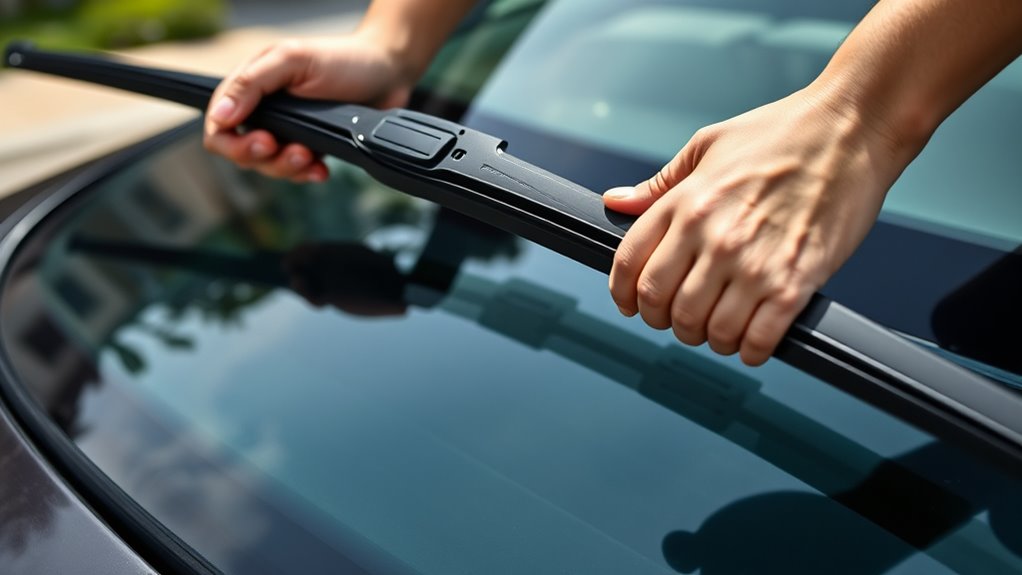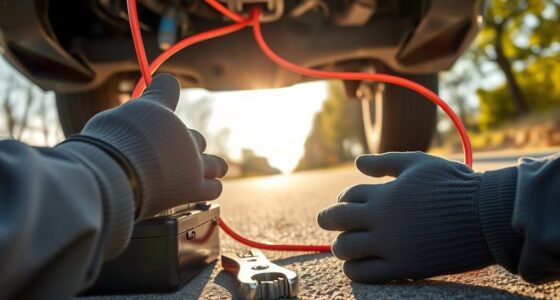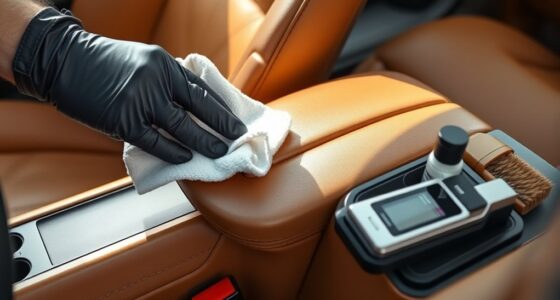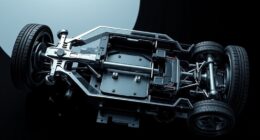To replace your wiper blades quickly, start by lifting the wiper arms away from the windshield, then identify their attachment type—hook or pin. If it’s a hook, press the release tab and slide the old blade off; for pin-style, unscrew or unclip as needed. Attach the new blades by aligning the connector with the arm and clicking or securing it in place. Lower the arms gently, test your wipers, and you’ll see how simple and fast the process can be. Keep going to learn more tips!
Key Takeaways
- Lift the wiper arm away from the windshield and note the attachment type.
- Remove the old blade by pressing tabs or sliding it off the hook or pin.
- Match the new blade to your vehicle’s specifications and attachment method.
- Secure the new blade onto the wiper arm until it clicks or locks into place.
- Lower the wiper arm and test the blades for smooth, streak-free operation.

Replacing your wiper blades is a simple task that can considerably improve your visibility during bad weather. It’s a quick fix that guarantees your windshield stays clear and your drive remains safe. Before you start, it’s helpful to understand the different wiper blade types available. Typically, you’ll encounter traditional frame-style blades, which have a metal frame supporting the rubber, and beam blades, which are made from a single piece of rubber and are more aerodynamic. Some newer models also feature hybrid blades, combining aspects of both. Knowing your wiper blade types assures you select the right replacement when shopping.
To begin, you’ll want to lift your wiper arms away from the windshield. Be gentle but firm, as yanking or forcing the arm can damage the mechanism. Once lifted, inspect the connection point where the blade attaches to the wiper arm. Most blades use a hook or pin system. If you see a hook, you’ll need to press a small tab or button to release the blade. For pin-style connectors, you might need to slide the blade off or unscrew it. Carefully remove the old blade, noting how it’s attached. This step helps you understand the type of connection you’ll need to replicate with your new blades.
When choosing new wiper blades, make sure they match your vehicle’s specifications. Check your owner’s manual or look for labels on your existing blades for the correct size and type. Installing is straightforward: align the new blade’s connector with the wiper arm’s hook or pin, then secure it by pressing or sliding into place. Be sure it clicks or locks in securely to prevent it from falling off during use. Once attached, gently lower the wiper arm back onto the windshield. Test the new blades by turning on your wipers and observing their movement. They should glide smoothly, leaving no streaks.
Regular maintenance tips keep your wiper blades in top shape longer. Clean the blades with a damp cloth and a bit of windshield washer fluid to remove dirt and debris. Check for cracks or tears in the rubber, and replace the blades if they’re worn or damaged. Avoid using your wipers on a dry windshield, which can cause unnecessary wear. Also, park your vehicle in the shade when possible; prolonged sun exposure can degrade rubber over time. Replacing wiper blades periodically not only improves visibility but also extends the lifespan of your entire windshield cleaning system, making sure safe driving in any weather.
Frequently Asked Questions
Can I Replace Wiper Blades Myself Without Tools?
Yes, you can replace wiper blades yourself without tools. For DIY tips, choose compatible blades and handle the process carefully. Usually, no special tools are needed—just your hands. Most wiper blades have a release tab or clip that you press to detach the old blade and snap on the new one. Follow the instructions specific to your vehicle, and you’ll have new wipers in minutes without any extra tools.
How Do I Choose the Right Wiper Blade Size?
To select the right wiper blade size, start by checking your vehicle’s manual or measuring the existing blades for measurement accuracy. Guarantee compatibility by choosing blades designed for your car’s make and model, as different vehicles require specific sizes. Use a measuring tape to confirm length, and verify that the blades fit securely on your wiper arms. Correct sizing ensures peak performance and clear visibility during inclement weather.
Are There Different Types of Wiper Blades for Specific Vehicles?
Just like choosing the right shoes for different terrains, you need specific wiper blades for your vehicle. There are various types, such as rain sensor blades that automatically adjust for rain, and winter blades designed to handle snow and ice. For example, if you drive in snowy conditions, winter blades prevent clumping. Always check your vehicle’s manual to guarantee you pick the correct type for ideal visibility and safety.
How Often Should I Replace My Wiper Blades?
You should replace your wiper blades every 6 to 12 months, depending on their lifespan and weather impact. Harsh weather, like snow or extreme heat, can wear down blades faster. Regularly check for streaks, cracks, or missing rubber, and replace them promptly to guarantee maximum visibility. Proper maintenance protects you from driving hazards and keeps your windshield clear, especially during seasonal changes or heavy rain.
What Are Signs That My Wiper Blades Need Replacing?
Your wiper blades are like loyal guardians on stormy nights, and signs of wear tell you when they’re losing their battle. If you notice streaks, smears, or squeaking during wiper blade maintenance, it’s time for a change. Cracks or tears in the rubber also signal worn-out blades. Don’t ignore these signs—replacing them promptly keeps your windshield clear and your drive safe, ensuring your wipers stay sharp when you need them most.
Conclusion
Replacing your wiper blades is quick and easy, and now you’re all set to see clearly no matter the weather. Just remember, a stitch in time saves nine—so don’t wait until your blades are completely worn out. With these simple steps, you can handle it yourself and keep your windshield spotless. Keep a close eye on those blades, and you’ll be able to hit the road safely and smoothly whenever you need to.









